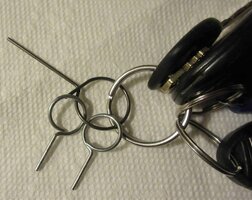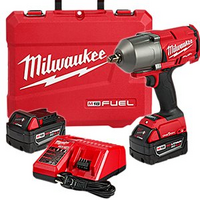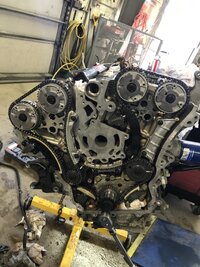Part I of III:
Notes from The Edge of Nissan Hell… But the Lessons Learned here WILL have Universal Value:
https://www.flickr.com/photos/126111508@N07/sets/72157677401630977
On February 1st, 2019… I ventured up to North Florida on a Mission of Mercy for what I thought would be “...just a few days...” to help my son by attempting to repair his 2007 Nissan Quest 3.5L Engine after it suffered a catastrophic failure of its entire Timing Chain System. 24 Days later… I emerged battered but intact from this ‘Port of Hades’; but only after great difficulty in successfully disassembling and then rebuilding the entire top end and the entire operational front area of this absurdly complex and very touchy ‘Interference Engine’.
The GM Atlas engine cannot hold a candle to the difficulties I encountered here when trying to replace (3) Sets of Timing Chains (4) Timing Chain Guides and (3) Timing Gear Cogs and get them all exactly right… but from personal experience here now after working on BOTH of these “Interference Engine” platforms… the prior encounters of working on the 4.2L Engine made all the difference in my being able to understand all of the problems and implications concerning the Nissan 3.5L V6 Engine...and to getting all of this work done right.
I somehow managed to accomplish this ridiculously troublesome task while working out of an exposed Metal Building nested on farmland property situated in a depressed bowl of the landscape that invited Cold, Damp and foggy air to constantly cascade down inside of that building, night after night. The net effects of these conditions explained why every single tool and metal surface even vaguely related to Ferrous Metals therein… were Rusted Solid and made useless!
It followed on that once the Engine sealed areas were opened up… every single thing similarly made of Cast Iron and Steel both on and inside of the exposed areas of this engine; post dis-assembly, tried to do likewise and Rust Up. In the end ...the only solution to preventing that artifact from repeating the “Rust Ups” day after day...was to constantly run a Space Heater close to the front of and underneath the work area for over three weeks… Nothing else worked to stave off these damaging elements. Using a regular source of heat cut down on my having to constantly chase all over the engine with wipes and cans of Freeze-Off, Kroil and WD-40 Penetrating Oil that nightly mixed into an ungodly damp slurry after all those surfaces coming into contact with Ice Cold “Mountain Dew”...FOR REAL!
More to Follow in (10) Minutes.
Notes from The Edge of Nissan Hell… But the Lessons Learned here WILL have Universal Value:
https://www.flickr.com/photos/126111508@N07/sets/72157677401630977
On February 1st, 2019… I ventured up to North Florida on a Mission of Mercy for what I thought would be “...just a few days...” to help my son by attempting to repair his 2007 Nissan Quest 3.5L Engine after it suffered a catastrophic failure of its entire Timing Chain System. 24 Days later… I emerged battered but intact from this ‘Port of Hades’; but only after great difficulty in successfully disassembling and then rebuilding the entire top end and the entire operational front area of this absurdly complex and very touchy ‘Interference Engine’.
The GM Atlas engine cannot hold a candle to the difficulties I encountered here when trying to replace (3) Sets of Timing Chains (4) Timing Chain Guides and (3) Timing Gear Cogs and get them all exactly right… but from personal experience here now after working on BOTH of these “Interference Engine” platforms… the prior encounters of working on the 4.2L Engine made all the difference in my being able to understand all of the problems and implications concerning the Nissan 3.5L V6 Engine...and to getting all of this work done right.
I somehow managed to accomplish this ridiculously troublesome task while working out of an exposed Metal Building nested on farmland property situated in a depressed bowl of the landscape that invited Cold, Damp and foggy air to constantly cascade down inside of that building, night after night. The net effects of these conditions explained why every single tool and metal surface even vaguely related to Ferrous Metals therein… were Rusted Solid and made useless!
It followed on that once the Engine sealed areas were opened up… every single thing similarly made of Cast Iron and Steel both on and inside of the exposed areas of this engine; post dis-assembly, tried to do likewise and Rust Up. In the end ...the only solution to preventing that artifact from repeating the “Rust Ups” day after day...was to constantly run a Space Heater close to the front of and underneath the work area for over three weeks… Nothing else worked to stave off these damaging elements. Using a regular source of heat cut down on my having to constantly chase all over the engine with wipes and cans of Freeze-Off, Kroil and WD-40 Penetrating Oil that nightly mixed into an ungodly damp slurry after all those surfaces coming into contact with Ice Cold “Mountain Dew”...FOR REAL!
More to Follow in (10) Minutes.





